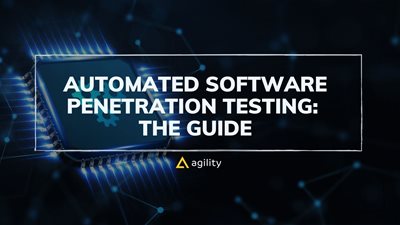Automated Software Penetration Testing: The Ultimate Guide


Data security should be a top priority if you manage your business through a website. Performing automated software penetration testing is one way to achieve your security requirements. This article explains what software penetration testing is and how you may benefit from doing it automatically. We’ll explain how it is different from manual testing, and we'll also give you steps on how to get started with automated software penetration testing.
Software Penetration Testing
It's a testing method used to evaluate the security of a system or application by simulating attacks and observing its response. This type of testing can be used to find vulnerabilities in systems, and help businesses to fix these issues before they are exploited.
Why Automate Software Penetration Testing?
There are several advantages of using automated software pentest tools. One of the most significant benefits is that it may help you save time. You may quickly and simply discover flaws in your systems by automating the testing process. This implies you can fix these problems before they do any harm to your company.
Another benefit of automated software penetration testing is that it's more accurate than manual testing. This does not mean it won't give you false positives but it will reduce room for human error. To avoid wasting time and resources tending to false positives, these tests should be performed by a professional.
How is it different from manual penetration testing?
Manual penetration testing involves security experts who manually exploit the vulnerabilities to get deep insights into them and ensure there are no false positives. A manual pentest report comes with step-by-step guidelines to reproduce and fix vulnerabilities, that is something you cannot expect in the case of automated software penetration testing.
Moreover, while working with manual pentester you can get in call support from them if your developers hit a roadblock while trying to remediate the issues.
10 Steps To Perform Software Penetration Testing
Step One: Identify the target
First, you need to identify which systems and networks you want to test. This will help you to scope the testing process and ensure that you're not wasting time on systems that don't need to be tested.
Step Two: Plan the attack
Once you've identified your targets, you need to plan your attack. This includes deciding which tools and techniques you'll use, as well as what type of data you want to collect.
Step Three: Perform the attack
After you've planned your attack, it's time to execute it. This involves using the tools and techniques that you've selected to attempt to exploit the vulnerabilities in your target systems.
Step Four: Collect the data
As you perform the attack, you'll need to collect data about the systems that you're testing. This will aid you in testing as well as help you understand the system better.
Step Five: Analyse the data
Analyzing the data will help you to understand what vulnerabilities exist in your target systems, and how they can be exploited.
Step Six: Report the findings
After you've analyzed the data, you need to report your findings. This report should be provided to the owners of the systems that you've tested. It should list the flaws, as well as guidance on how to repair them.
Step Seven: Retest
When the flaws have been addressed, it's critical to retest the systems to ensure that they are secure. This will guarantee that the issue was indeed resolved.
Step Eight: Monitor
even after you've retested the systems and they're secure, it's important to monitor them for any new vulnerabilities.
Step Nine: Update
As new vulnerabilities are discovered, it's important to update your testing tools and techniques to always be one step ahead of the attackers.
Step Ten: Repeat
The final step is to repeat the entire process on a regular basis. This will assist you in maintaining your website's security against future attacks.
What to do before starting?
- Choose the right tools: There are many different automated software penetration testing tools available. Choosing the best penetration testing tool can make all the difference in the success of your testing.
- Train your staff: Before you start using automated tools, it's important that you train your staff on how to use them. This will help to ensure that they're able to properly use the tools and understand the results.
- Get approval: Before you begin testing, it's important to get approval from the owners of the systems that you'll be testing. This will help to ensure that they're aware of what you're doing and why.
- Understand the risks: Automated software penetration testing can be risky. It's critical to comprehend these threats before you begin so that you don't encounter any issues as a result of your actions.
It is of paramount importance that your penetration testing plan aligns with your business goals and does not meddle, in any way, with the regular business functionalities.
How to choose the right software penetration testing tool for your business?
The right tool can go a long way when it comes to security testing, similarly, the wrong pentest partner can cost your business dearly. You should be aware of two kinds of features in an automated pentest tool.
The first kind consists of high-level features like the number of tests, the compliances covered, the quality of the vulnerability scanning report, etc. The second kind takes into account the small internal features that often do not even appear on the first page of the marketing website, but can have a great impact on the user experience and the value you actually get out of it.
These are features like continuous testing, CI/CD integration, integration of the pentest tool with Slack, scanning behind logged-in pages, etc.
When you go ahead to choose an automated software penetration testing tool, keep both kinds of features in mind. A tool that conducts 3000+ tests, helps you with compliance reporting, scans behind a login, and also allows you to automate scanning for all future updates of your software application, is the kind of tool you should be looking for.
Conclusion
Automated software penetration testing is an important component of keeping your systems safe. You may quickly and easily identify security weaknesses in your website using these tools. This indicates that you can avert any harm to your company before it happens.

About the Author
Agility CMS is Canada's original headless CMS platform. Since 2002, Agility has helped companies across Canada and around the world better manage their content. Marketers are free to create the content they want, when they want it. Developers are empowered to build what they want, how they want.
- Get a demo for a personalized walkthrough.
- Try for FREE and experience Agility CMS.
- Contact us with your questions.
View Related Resources

4 Ways to Integrate Cybersecurity Automation In Your Enterprise

Mitigating a cybersecurity nightmare: avoid open source software

Ecommerce cybersecurity threats: how to protect your website
A secure environment is always mandatory. You shouldn't have to compromise.
From data security to privacy and compliance, maintaining enterprise-grade security is an ongoing process. We keep your data safe and ensure compliance, today, tomorrow, and in the future.
Learn More